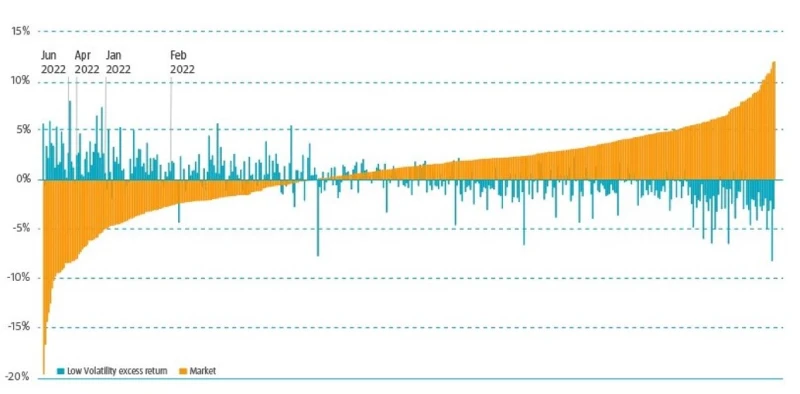Low-risk strategies such as Conservative Equities are designed to provide risk reduction in volatile down markets, which typically comes at the expense of lagging in strong bull markets. Over an investment cycle characterized by these ups and downs, the compounded long-term returns tend to be similar or higher than the market, resulting in higher risk-adjusted returns. This effect can be epitomized by the catch phrase ‘winning by losing less’ and is contrary to the belief that higher risk leads to higher returns in the long run.
Figure 1 visualizes this concept of downside protection by showing the excess returns of the lowest volatility quintile portfolio versus the market, alongside the corresponding market returns. The months are then ordered from the lowest market returns to the highest.
Figure 1 | Winning by losing less, January 1986 to June 2022

Source: Refinitiv, Robeco. The chart shows the monthly excess returns of the lowest volatility quintile portfolio versus the market, alongside the corresponding market returns. The months are then ordered from the lowest market returns to the highest. Volatility is measured as the past 156-week return volatility. The investment universe consists of MSCI World and MSCI Emerging Markets indices constituents. Before 2001, we use the FTSE World Developed Index for developed markets (going back to December 1985) and the largest 800 constituents of the S&P Emerging BMI at the semi-annual index rebalance for emerging markets (going back to December 1995). The portfolios are value-weighted and rebalanced monthly. The sample period is from January 1986 to June 2022.
This illustrates how low-risk strategies are typically useful for investors when they most need protection. Building on more than 150 years of evidence which demonstrates the efficacy of the low volatility anomaly, low-risk stocks have yet again demonstrated their defensive characteristics by providing risk reduction in months when the market has charted into negative territory this year. As a result, low-risk strategies have delivered better year-to-date returns than the market.
Low Volatility investing: now more than ever?
There is an expectation that the current market volatility will continue to persist in the foreseeable future given the looming risk of recession, stubbornly high inflation, unstable geopolitical situation and normalization of monetary policy which is leading to higher real yields. Against this backdrop, we believe there is a case for low volatility investing now more than ever.
Discover the value of quant
Subscribe for cutting-edge quant strategies and insights.



















